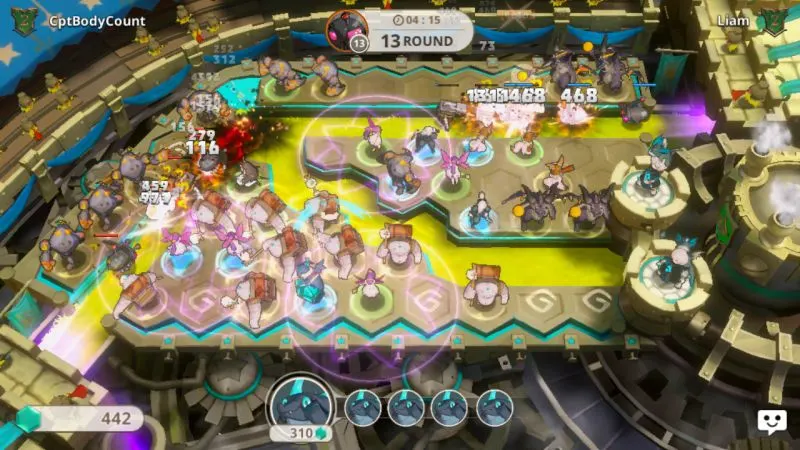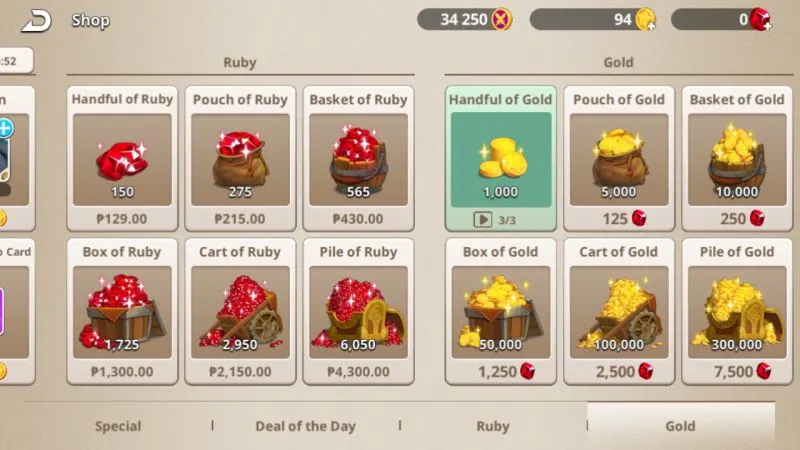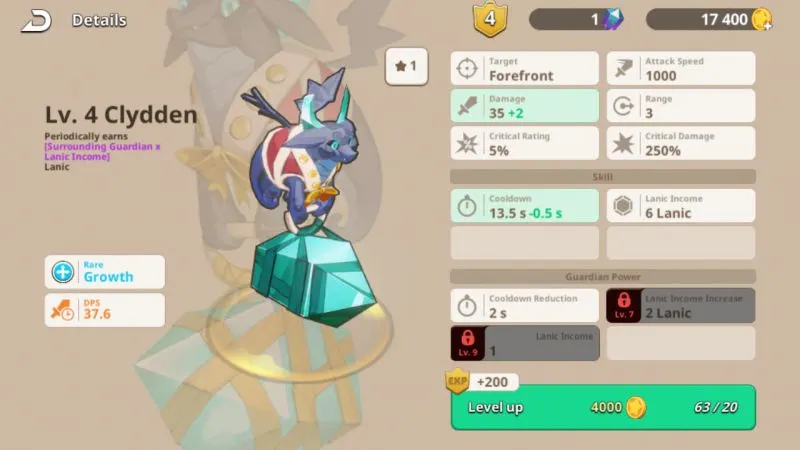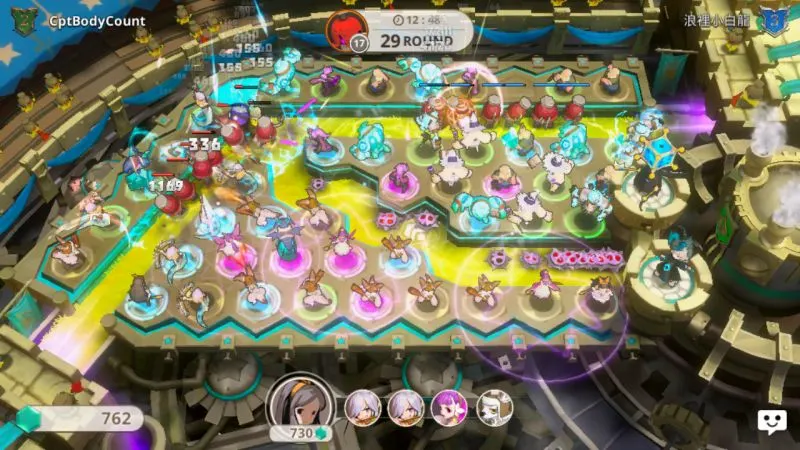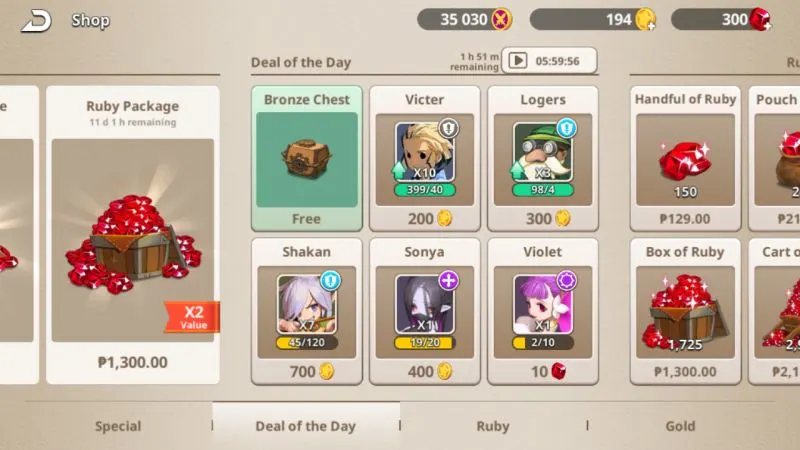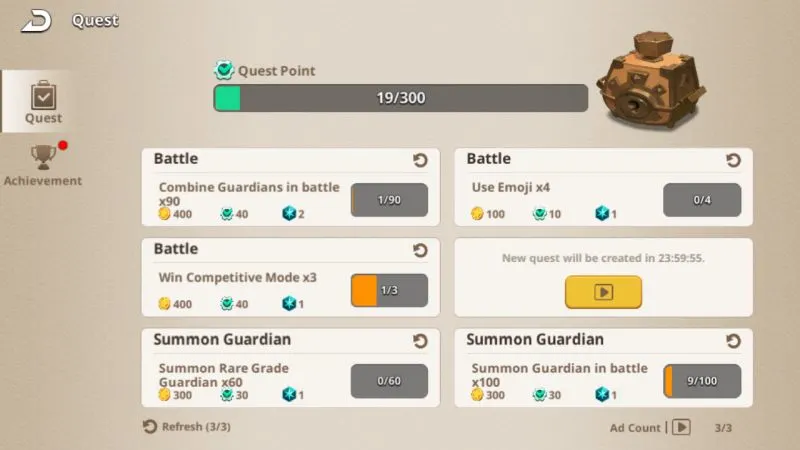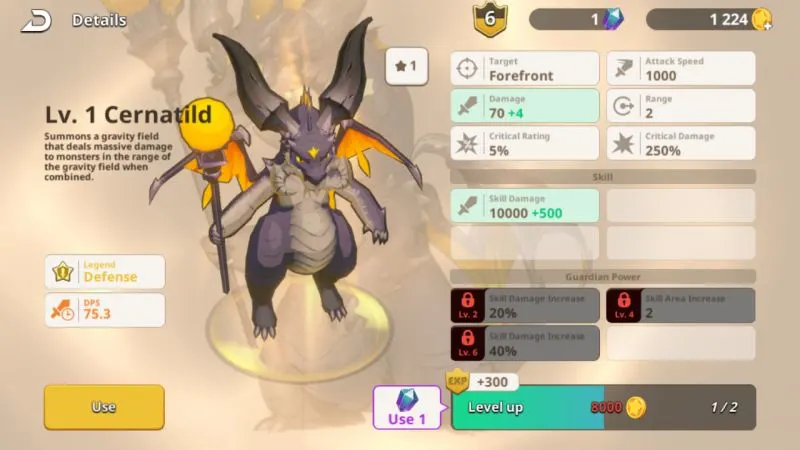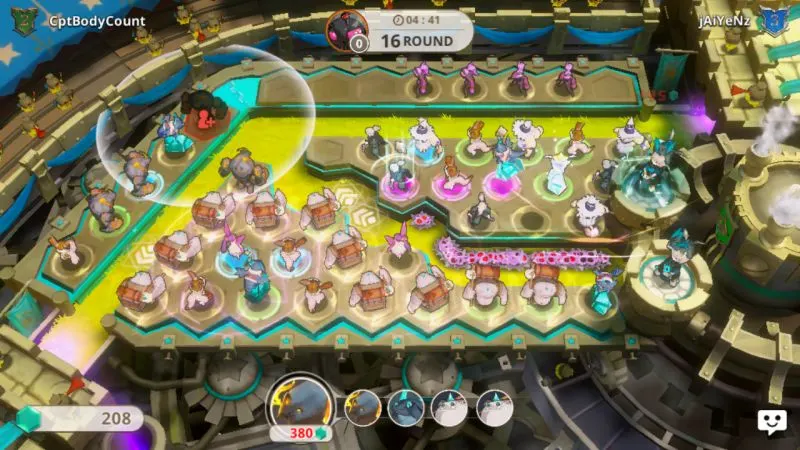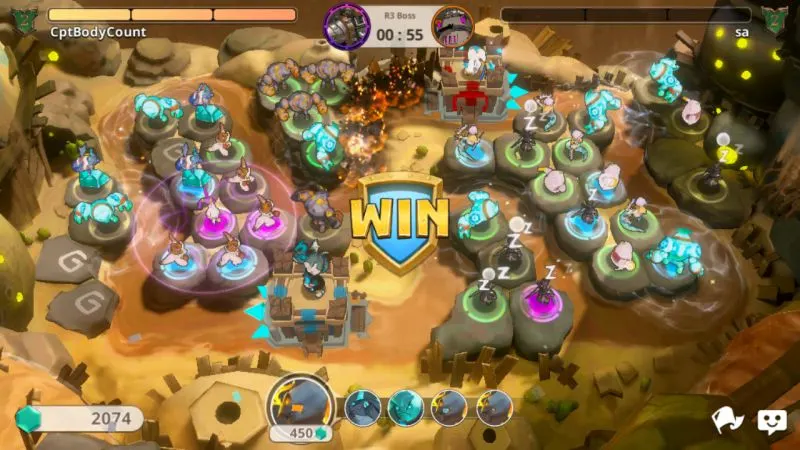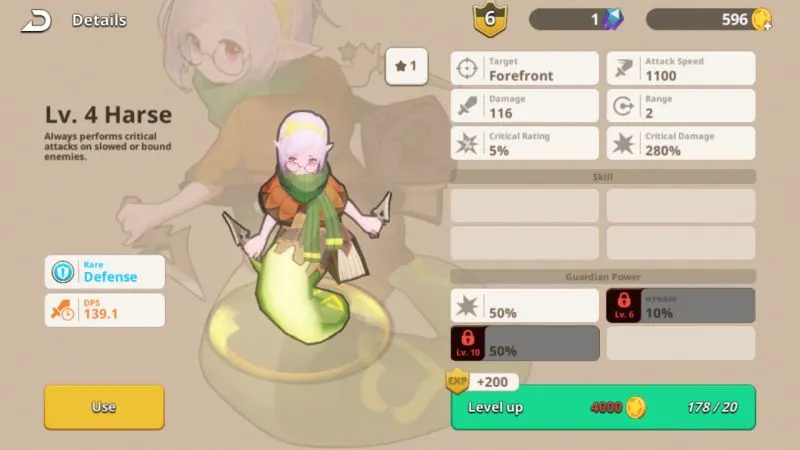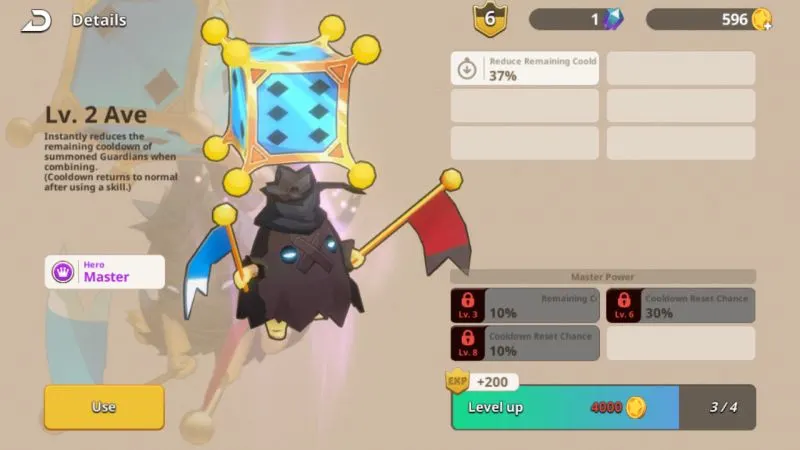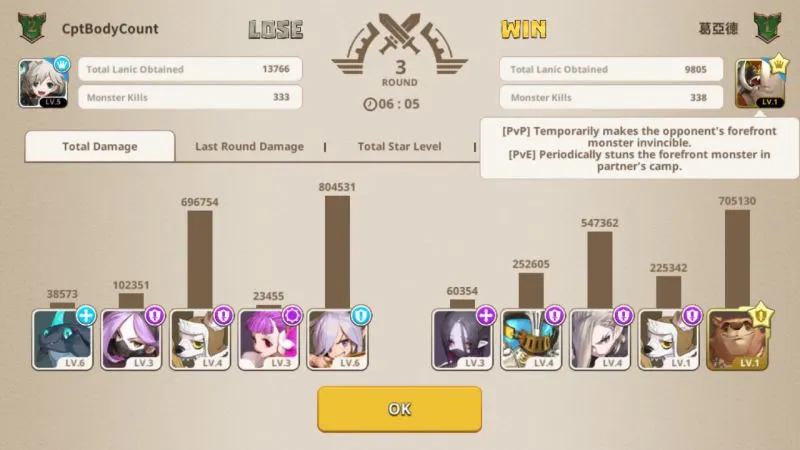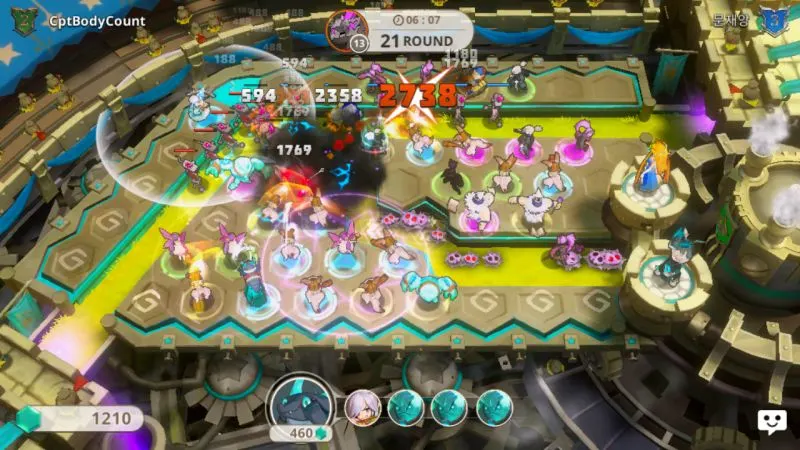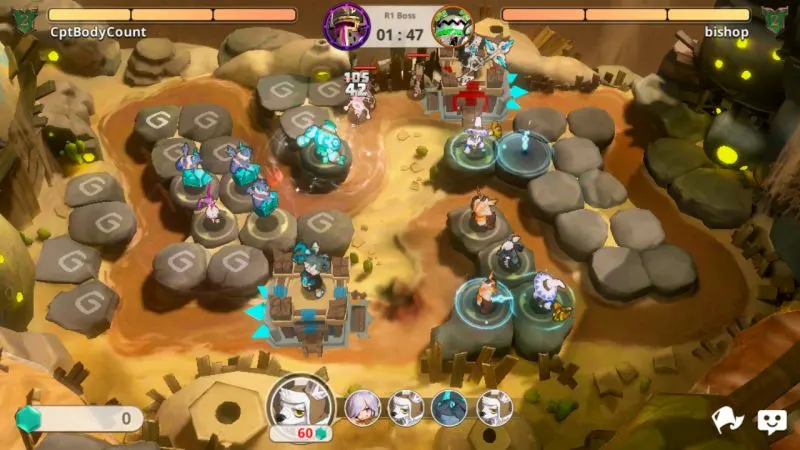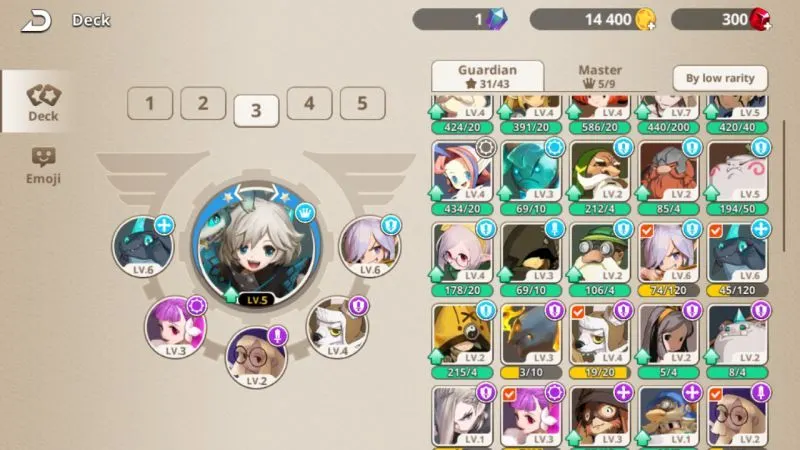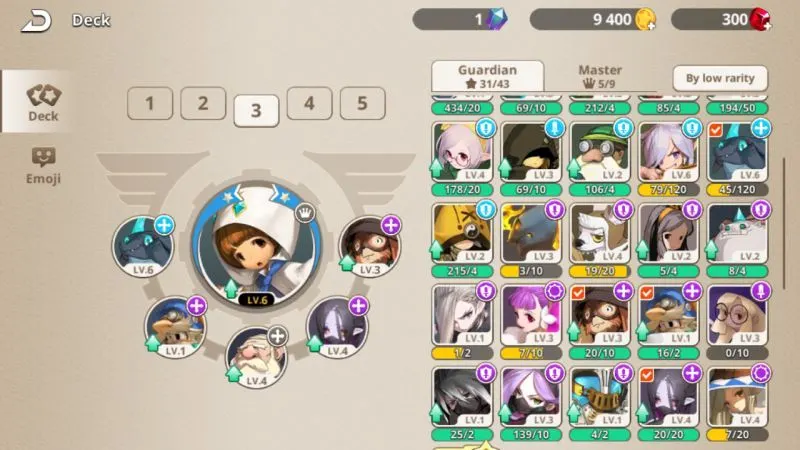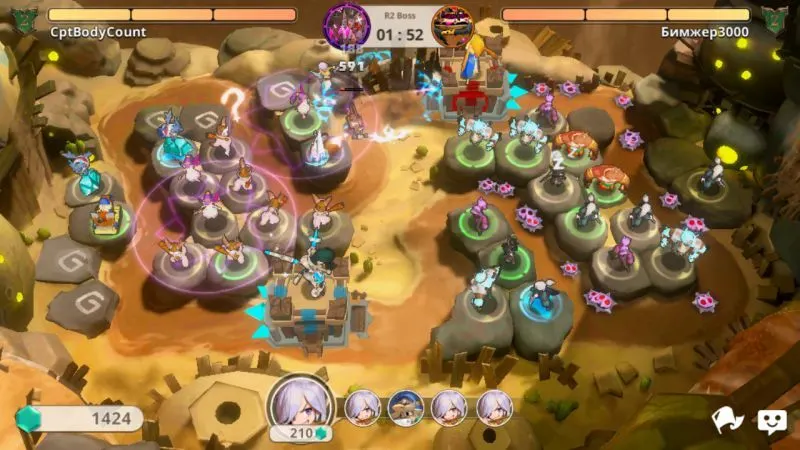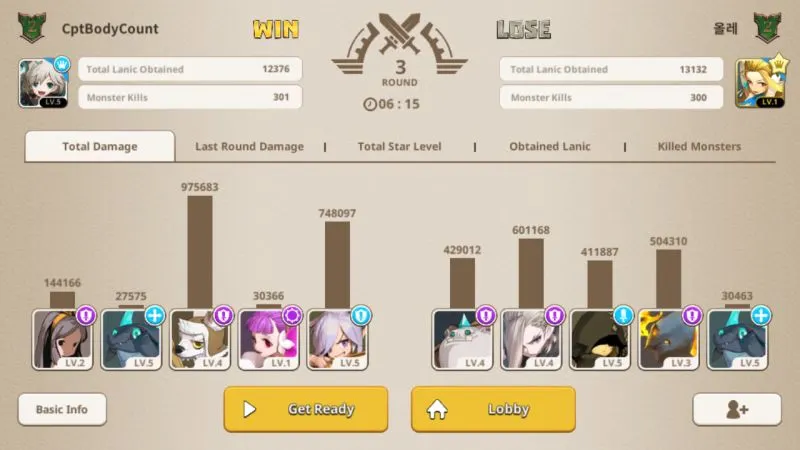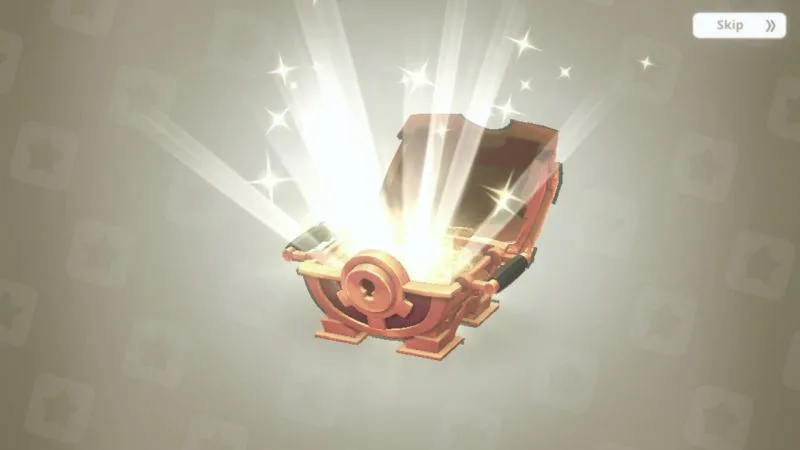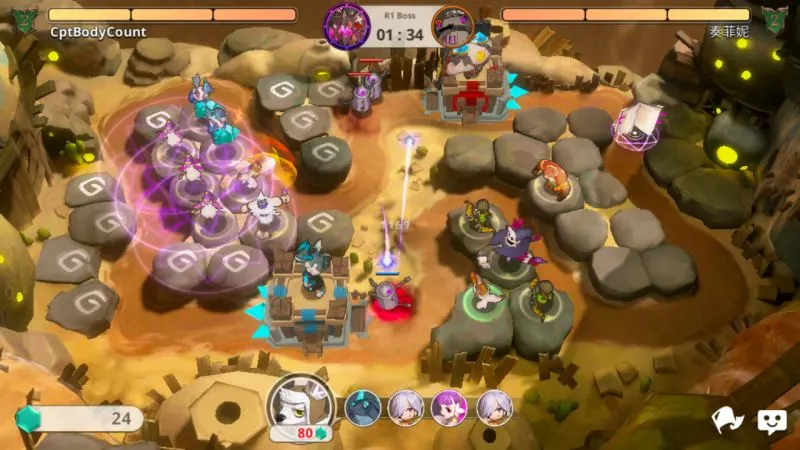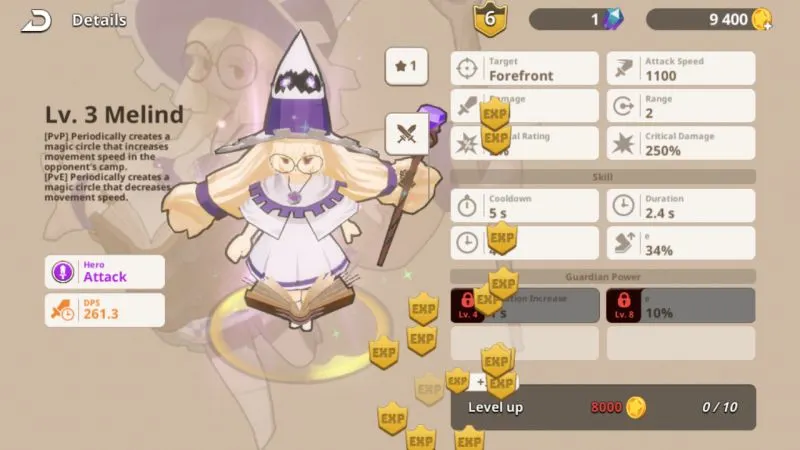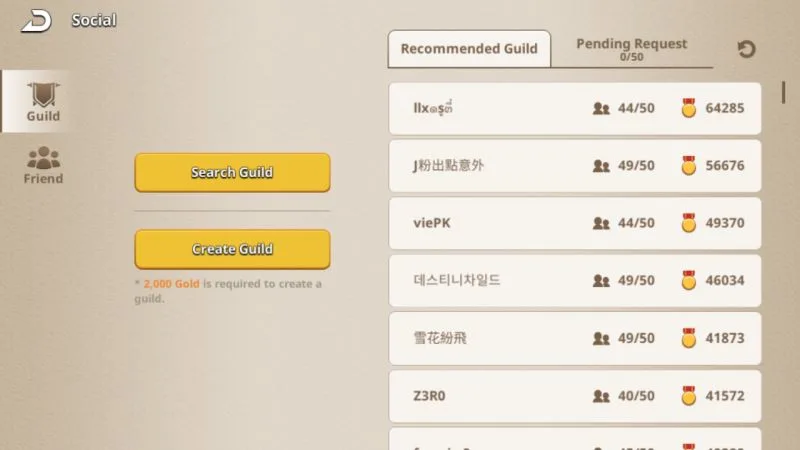Welcome to our Guardian Chronicle beginner’s guide! Guardian Chronicle is a tower defense (Well, not exactly towers considering you’re using people) game much akin to titles such as Arknights and the Bloons series with a more fantasy-steampunk anime bias. From big scary tough guys like the Burning Golem to cute-looking snake people like Sonya, you aren’t short of pretty designs to look at in this game. Another thing you aren’t short on would be tactical options, as a Guardian’s rarity isn’t nearly as important as how they pair with their buddies, and where you put them on the map.
We won’t mince words here, this game is grindy. Knowing this, you shouldn’t rush play this for several hours at a time. The first hour or so you log in a day is usually going to be your most efficient, and past a few games your in-game rewards won’t really amount to much. Mainly because you get massively boosted rewards for your first four Coop matches everyday, and once you complete two sets of your ad-refreshable daily quests, you’re goning have to wait until the next day to get new ones.
That being said, that doesn’t mean you can’t squeeze the most out of that hour or two! And we’re here to help you with that, so be sure to check out our Guardian Chronicle beginner’s guide below for some much-needed tips, tricks and strategies!
1. Adverts In Your Eyes
As annoying as watching ads can be, a 30 second wait is way better than several hours. You can watch ads to refresh the Shop’s Deal of the Day once per day, refresh quests after you finish them, get free gold from the Shop up to 3 times a day, and get Guardian points after a Competitive match gone wrong. Not only is it free stuff for basically no effort, it supports the devs. They need to keep the servers running after all.
2. A Different Meaning To Pay2win
In a battle, you use Lanic to summon new Guardians into the field. Never ever go into a battle without any form of passive Lanic income. Ever. Don’t even THINK about it. That’s the equivalent of forgetting to build ore refineries in Command and Conquer, you can’t have an army without funding. A good choice for passive Lanic income would be Clydden, a tubby little flying dragon guy carrying a big crystal.
While his income starts out small, it is multiplied by the number of Guardians next to him, along with his star level. This allows him to make a decent amount of income without taking up too much space, which is better taken up for more combative units. In his absence though, even a bad Lanic income unit is better than none at all. You earn 10 Lanic per kill if you don’t have any Lanic-mining Growth Guardians, which isn’t nearly enough when each new Guardian in the field starts costing 500 Lanic.
3. Co-op For Profit
Say you’ve been having a bad time in Competitive mode. If you notice you’re losing pretty often due to the matchmaking consistently sending you against players that have higher level units, it might be time to go play Co-op mode.
Co-op Mode gets you more Battle Coins than Competitive Mode does, which allows you to get chests full of gold and cards. In fact, it might be a better idea to play Co-op Mode more often, especially if you’re a new player. You’ll need that leveling money!
4. Keep An Eye On Your Dailies
Most of your income will come from your various daily rewards and the Daily Deals, along with the Battle Coin chests and the Guardian Pass. Battles in and of themselves have fairly small gold rewards, though they are the primary way to get Battle Coins and Guardian Points. Check your dailies, remember to refresh your quests by watching ads once you finish them, and profit.
5. Choosing Quests To Refresh
You just finished all your quests. Hurray! Unfortunately you forgot to refresh them immediately, or hey your refreshes were done recharging. Hurray again. You only have 3 quest refreshes, and it takes a day for them to recharge.
When picking which quest slot to refresh, look for whatever has the longest wait time. Don’t refresh a quest if it’ll be ready in 5 minutes, use the refresh on a quest slot that wants you to wait for a day! If all of them are about 5 minutes away anyway, just save the refreshes.
6. Knowledge Over Rarity
Each Guardian is very different in how they work. Reading their description and their stats is much more important than taking note of their rarity. For one thing, one of the best Lanic generators is a mere Rare, and Normals often have simple attacks mixed with decent enough stats.
On the other hand, some Legendaries can be fairly hard to use, such as Cernatild, a spell-casting dragon. You’d think he’s very powerful being a legendary, and he is!… About a tenth of the time he spends on the field anyway. His skill deals a stupidly powerful 10000 damage at star level 1, across a very wide AOE. Unfortunately, to activate it, you need to merge units into Cernatild to do it.
This wouldn’t be so bad, if it weren’t for the fact Cernatild’s basic attack hits about as hard as a starving child throwing a crumpled piece of paper at you. That being said, if the queue starts spamming him in your face, you can enjoy a big, destructive fireworks show as long as they end up in the same star level.
7. Unit Setup
Most units in this game require some form of setup to be effective. Normal rarity Guardians often have high stats and little need for setup, but also lack special abilities or synergies that let them make the most of their stats. Such units with low setup are often easy to use, but also a relatively low power ceiling.
One good example of a unit that requires setup is Mabo, an Epic DPS Guardian. When chained together, each individual Mabo gets stronger, every single one of them getting a damage bonus of 18% per Mabo in the chain. That means a chain of 5 Mabos gives every Mabo in the chain an extra 90% damage per hit. For him to be effective, you need to set up a long string of Mabos. But once that’s done, the shredding begins. Now all you need to do is slap Violet and her attack speed buff behind them to power them up even more!
8. Positioning Matters
After you’re done reading everything about your favored team, you should figure out where on a map each Guardian will cause the most pain for the enemy. You don’t want to put support units with AOE auras like Violet in a spot where there’s little room for people next to them, and you wouldn’t want to put AOE units way out back where their area attacks will hit fewer enemies.
Units like the Burning Golem are best put in a position ready to reach the enemy spawn area, so their AOE attacks (in the Burning Golem’s case, them setting the floor on fire in a manner that stacks) soften up as many enemies as possible. Then the DPS units directly behind them can rip what’s left of them to tiny little pieces. An example of a unit extremely dependent on their positioning is Aqualop.
He makes an enemy-slowing water pool around him that persists for as long as he’s there. He’s best put on a sharp turn, so his water pool covers as much area as possible. You could put him all over the map to slow the enemies to a crawl, but you could use that space for actual proper damage dealers instead. After all, the enemy can’t move if they’re dead!
9. Focus On Teamwork
Some Guardians work best with other Guardians to help them. Support Guardians are generally good for this, but some Guardians can be pretty specific about what they want. For one thing, Harse is a picky little snake nerd who basically demands you put her next to Aqualop or other Guardians who can slow or bind enemies down. She does guaranteed crits against slowed or bound enemies, and swings rather fast. Unfortunately, without those crits, her damage per hit is pretty pathetic at roughly 100 at one star. Most support Guardians hit for 200 damage or so at 1 star. Make sure you bring units that synergize well with each other.
10. Master And Commander
Another type of card, apart from Guardians, is the Master. A Master is your representative on the battlefield, sitting on top of that cute little door your Guardians are protecting. Just like Guardians, every Master is very different from one another. As such, you will often have to make a deck or battle plan centered around your Master, especially with the more complex ones.
For one thing, if everyone on your deck lacks timed Skills, Ave becomes rather useless since his ability is to partially refresh skill cooldowns every time you merge your Guardians. On the other hand, he’s pretty hilarious when you have a line of Burning Golems dousing half your road with flaming gasoline, or a squad of Melinds spamming magic speed circles all over the enemy player’s road.
11. Watch Your Replays, Especially If You Lose
Perhaps more painful than watching ads, is the shame of reliving a battle where you failed as a Master, and the enemy sent your Guardians packing. And just like watching ads, you get something from it. Not free stuff, but information. Looking at your Battle Records shows you not only an enemy’s build, but also whether or not their units are higher level than yours.
If you lost a match against an enemy with lower level Guardians, you better watch that match and learn how they beat you. Was it their superior positioning? Did they have a deck that synergized well? Did they pull some galaxy-brained guardian merging play? Or did they just get lucky with their queue?
Either way, it helps to take post-battle notes so you get a better idea how certain Guardians work, especially those you don’t own, haven’t used yet, or even those you thought were weak. Check the Details tab too, as it’ll let you know if you had too many of a certain Guardian on the board.
Seeing high damage numbers on a Defense Guardian is perfectly fine, but if you spot a Support with an unusually noticeable damage bar, you might have had too many of them in the field.
12. Bombarding Traffic Jams
Not to be confused with merging units into stronger units, we’re talking about that spot in the Co-op map where both streams of enemies join together. It is important to put this area within range of your AOE units.
As both your set of enemies and your buddy’s set of enemies arrive here, it provides a target rich environment for your AOE guys to hit the enemy. This also makes it a lot easier for the DPS guys out back to rip the survivors to pieces, for the obvious reason that they only need to fight a bunch of injured bad guys.
13. Merging Units
When merging units, remember that they always get merged into a stronger version of whatever’s first in your queue. Knowing this, don’t be afraid to put a unit you don’t want in a certain position to set up.
Say, as an example, you want to put Violet, an AOE buffer, in this nice nestled spot where she can buff as many people as possible. Unfortunately, you keep getting Clyddens you don’t need instead. Slap one of those Clyddens into Violet’s spot, then when Violet is about to appear in the queue, merge another Clydden into the other Clydden sitting in Violet’s spot. Bam, not only did Violet appear exactly where you wanted her, she’s a star level better than if you had waited and kept that spot free!
You could also use it to prepare your combat units: It’ll be funny if all those extra Violets that crowded your queue went to combat positions, then suddenly merged into a bunch of starred-up Roos as soon as they become available.
14. Guardian Roles
Each Guardian has a role, denoted by the symbol that also marks their rarity by color.
A shield with a sword denotes a Defense Guardian. Their primary focus is to kill the heck out of the enemies walking on your road. They’re your bread and butter units and will often be doing the biggest damage in your list, and taking up the most field space if the queue is nice to you. You’ll often put AOE Defense Guardians up front, and DPS Defense Guardians closer to the mid and rear of the road.
Support Guardians, marked by a sunny circle, often give buffs to nearby units, or debuff enemies on the road. They often do poor damage, but you’ll need them to make the most out of your Defense Guardians.
Growth Guardians are your miners: They provide Lanic through different means, or failing that, do some other weird thing to summon or star-up Guardians to your board.
Attack Guardians, marked by a sword with no shield, are the weirdest: In Coop, they often act similarly to the more offensive Support Guardians, doing things to hamper the enemy on the road, or buffing your partner instead of your own units. In Competitive though, they’re much funnier.
Attack Guardians do things to actively mess with the enemy player’s road and Guardians, such as making mobs on their road run faster or stunning their Guardians so they fight less effectively.
15. Same Intention, Disparate Methods
Again, read the units’ descriptions and stats to know exactly where you want them on the map. Just because both your units have the same job doesn’t mean they’ll do that job in the same manner. For example, Sonya and Popo have the same purpose, gathering Lanic. And yet, their effective spots on a map could not be more different.
Sonya is best placed far in front of the map, probably in a small group or with Violet next to her. Sonya gathers Lanic by slapping enemies with her short-range attack. If you place her out back and she somehow starts making money, that means you’re about to get overrun. Popo on the other hand gathers Lanic by shooting a Lanic bullet at a random enemy or partner player’s Guardian, with the target’s star level multiplying his earnings.
Unlike Sonya, not only can you place him anywhere and he’ll make money all the same, placing him in front is the worst thing you can do for him. Place him out back where he takes the most advantage of his extremely long range (but as expected of a Lanic miner, rather weak) attack. And no, we don’t suggest putting them together on the same team.
16. Bad Math With Merges
Sometimes, merging your units at a bad time can cost you a match. For one thing, you have to be careful with merging during difficult waves, as the way star level upgrades are calculated is simply the Guardian’s base stats multiplied by their star level.
Mix that with how you need two Guardians of equal star level to merge and go up one star level, and you’ll see the problem. A pair of star level 3 Guardians merged together don’t make a Guardian with 6x power, but a Guardian with 4x power, since it only makes a 4 star Guardian!
Later during a match, this becomes a question of opening field space vs maintaining your current army strength. If you need more space, especially if you just finished a wave, then it’s time to start merging. But if the enemy is going in hard, merging that one Burning Golem might just allow the bad guys to kick your doors down. Sometimes, you just need an army of low level Guardians instead of a single really strong one.
17. Tooth-To-Tail Ratio
Tooth-to-tail ratio is a term used by modern militaries to determine how many support personnel (the tail) it takes to maintain their combat units (the tooth). In the largest modern militaries, the tail is often longer than the tooth. In Guardian Chronicle, both a long tail, or a sharp row of teeth, have their advantages and disadvantages.
A balanced deck typically consists of an AOE Defense Guardian, a DPS Defense Guardian, a Lanic-based Growth Guardian, a Support, and a fifth slot that may take any unit depending on what your plan is, though not usually a Defense Guardian. This ensures your damage dealers are in top form. The downside is the trouble from the queue. It isn’t easy to place combat units down if all three of your non-combatant Guardians clog your queue all at once.
On the other hand, the advantage of a team made of mostly damage dealers is it makes the decision to merge far easier. No matter how you merge your units, you can be sure the guy who pops out will do some damage, provided they are placed well. It goes from “Oh no I have too many supports, and I can only merge them into Lanic miners!” to “Oh my miner filled my queue, I’ll just merge the extras into fighters later.”
Of course, don’t confuse having a DECK with more supports than combat units for a FIELD with more supports than combat units. The majority of your floor space should be taken up by your damage dealers, with your more varied supports placed in strategic spots to do their jobs most effectively.
18. Battle Chest Reset
Battle Chest prices reset every day. Knowing this, if the next chest isn’t worth the battle coin price, say it’s a Bronze chest at 10000 Battle Coins, don’t buy it. Especially if it’s followed by another bunch of Silvers and Bronzes. Instead, just wait the next day for a price reset. That way, you make the most of your Battle Coins.
19. Jenga Tower Buffs
Unless otherwise stated in a character’s description, buffs and debuffs don’t stack together. Having a Guardian sandwiched between two Violets will only take the strongest buff, as opposed to turning into a machinegun nest from both Violets.
And on the other side, Guardians like Icing will never completely freeze anything solid no matter how many of her are shooting a single target at once. Knowing this, you would need to spread Icing across the map in such a way as to freeze as many targets as possible, as opposed to having many of them focus the frontmost target down.
Of course, certain attacks that look like debuffs might not actually count as debuffs; The Burning Golem’s area flame isn’t a fire debuff, but something more akin to a persistent, lingering AOE projectile thing. As such, these DO stack. You don’t need a clump of Icings, but a clump of Burning Golems is perfectly okay.
20. To Level Or Not To Level
If you’re having a hard time winning even though your favorite Guardians are leveled as far as you can afford, it might be time to level those Guardians you’ve been neglecting. For one thing, leveling cards up gives your account EXP.
A higher level account gets a small buff to your initial Lanic income and your Guardians’ overall damage power. Another effect of this is opening your deck to new options. You don’t have to worry about putting low level Guardian cards into your deck if none of them are low level!
21. Make Some Friends
This is another game where the social aspect cannot be ignored. For one thing, that little Invite Friend button in the Co-op mode screen isn’t just for brotherly bonding: Inviting a friend to a match gets you and your buddy a boost in rewards, much like what you get for your first four daily Co-op matches. A ludicrous 10 times the normal reward at that.
You can only avail of the Friend Invite boost 3 times a day, but 3 matches with 10 times the pay (Win or lose!) isn’t something to scoff at. Then there’s Guilds, where you can request cards to finish your deck, and give cards away for EXP. Unless they’re Legendaries, apparently that’s pushing it.
In conclusion, use your noggin’ when playing Guardian Chronicle! That being said, this guide is here to help you with that. If you have any of your own tips, agreements and disagreements, or even a favorite deck composition, don’t be afraid to share them down below in the comment section!

